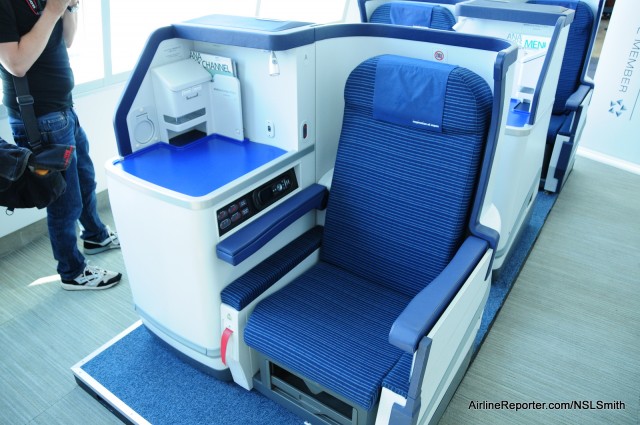
This is ANA's new international business class staggered seat on display at Boeing's Delivery Center.
Step by step Boeing is getting closer to delivering their first 787 Dreamliner to All Nippon Airways (ANA). Today was a huge milestone with revealing the special livery and allow media, ANA employees and invited guests the opportunity to take a look at the inside. This first aircraft that will be delivered (ZA101 – JA801A) will fly domestically with-in Japan, so it has ANA’s new domestic interior. ANA is proud of their new international staggered business class, so they had a few seats on display at Boeing’s Delivery Center that we were able to preview before heading out to the hangar.
I decided to give the seat a shot. At 6’1″ 250lbs, I was hoping for the best. I have flown in ANA international business previously and I really enjoyed the old product. Honestly, I felt the new seats seemed a bit bland looking, but I was told they were designed to look futuristic. The older product has wood and really gives a warm feel, but I suspect the new product will look much better in the aircraft and it does provide a lot more privacy and space to store your things. It is hard to get the full feeling of the seat with only three in a row on display versus seeing it in staggered configuration inside an airplane. Because of that, I will reserve final judgement for testing it out on a future international ANA 787 flight (fingers crossed on that one) or possibly on the newer Boeing 777-300ERs that are also flying the new staggered business class.
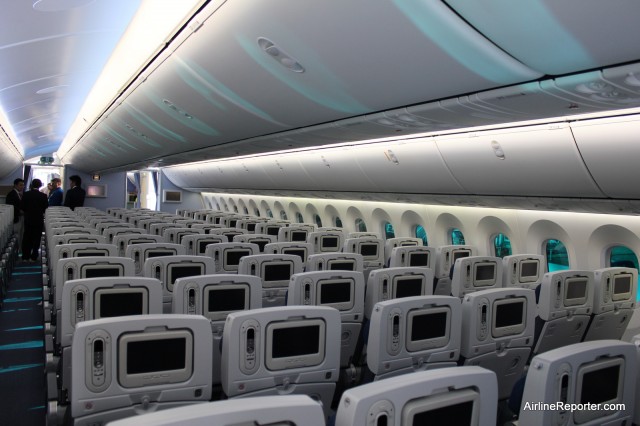
The tinted windows on the Boeing 787 Dreamliner makes odd "mood" lighting in the cabin.
I have felt privileged to previously been able to take an interior tour of Boeing’s third 787 Dreamliner, ZA003, but that one did not have a full interior. This aircraft looked like it was ready to take on customers with a full interior and it had that new plane smell (which smells very similar to a new car smell). When first walking on the 787 you get a feeling of space — it is not just Boeing PR talk, it is true. There are literal reasons with the overhead bins providing more space and the fact that the 787’s cabin is about 2.5 feet wider than the 767. The 787 also has LED lighting in the ceiling that also gives a greater sense of height and space.
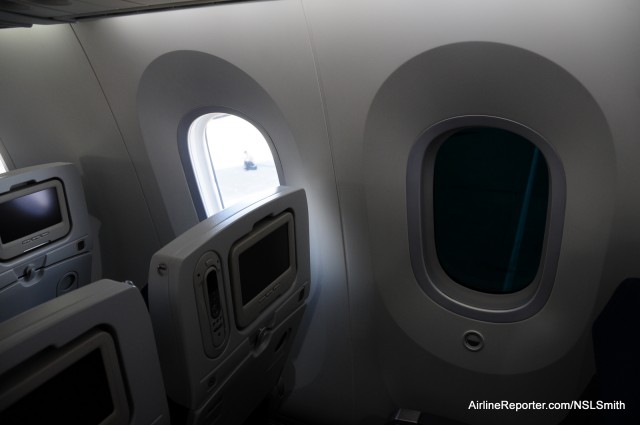
One window is clear, the other is darkened.
One of the many benefits of the 787 Dreamliner are the windows. Gone are the sunshades that either provide full light or complete darkness. The 787’s new smart-windows allow passengers to choose five different settings of tint. Even at the darkest setting, you are still able to see outside. The flight crew has control over all the windows at their computer station, giving them the ability to darken or lighten all the windows at the same time.
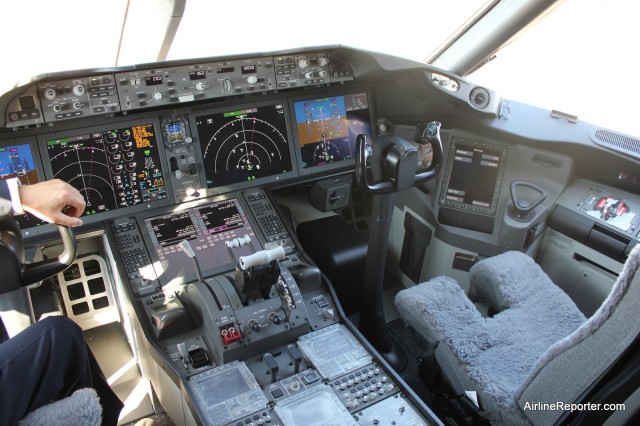
The best seats in the 787 Dreamliner are not in business class, but in the cockpit.
One cannot get a full interior tour, without a visit to the flight deck, which holds the best seats in the house. You could tell this 787 was new since there was protective plastic that was still on controls and displays around the cockpit. The pilots have an array of technology to make flying the aircraft easier and safer. Not only are there large screens that can easily show everything that is going on with the aircraft, but there are also Heads Up Displays (HUD) that allow the pilots to look out the front windscreen, while still seeing vital aircraft information like speed and altitude.
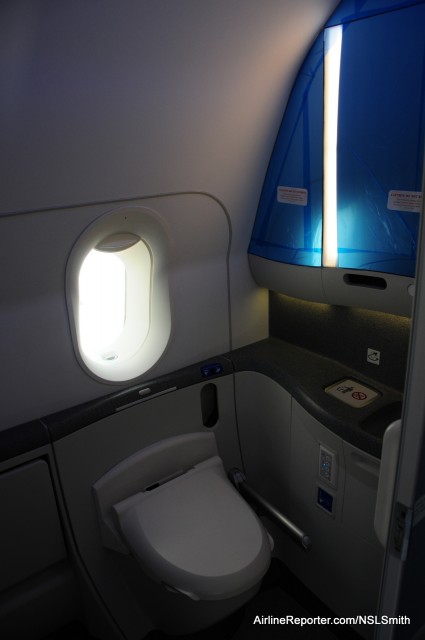
The center lavatory had a window. Notice the protective blue film still on the mirrors.
One of the most interesting features on the aircraft were the lavatories. First off, ANA has decided to offer female only lavatories, meaning that most restrooms will have an image of a male and female, but others will display a single female image. On this aircraft, the central lavatory had a window and the only shade on the aircraft. There is a dimming switch, but for those who want total privacy, you are able to pull down the shade. For those who are used to a certain level of service in the restroom, do not worry, each toilet has a bidet with special male and female settings.
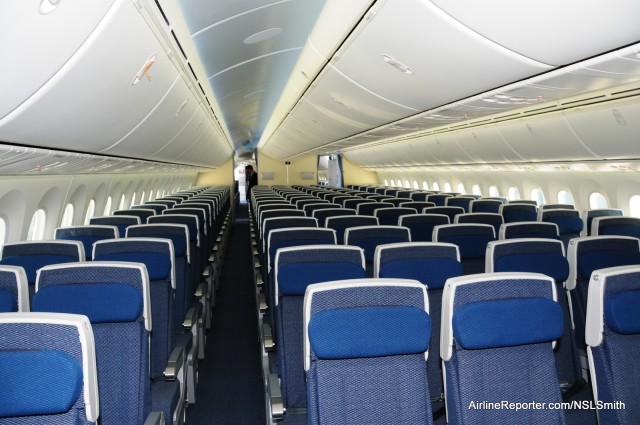
Looking to the back of the Dreamliner in Economy.
Since this was a 787 created for shorthaul flights, it has a small business class section and then economy in the rear of the aircraft. ANA was originally planning an economy-plus type section, but have decided not to implement that in this 787 for now.
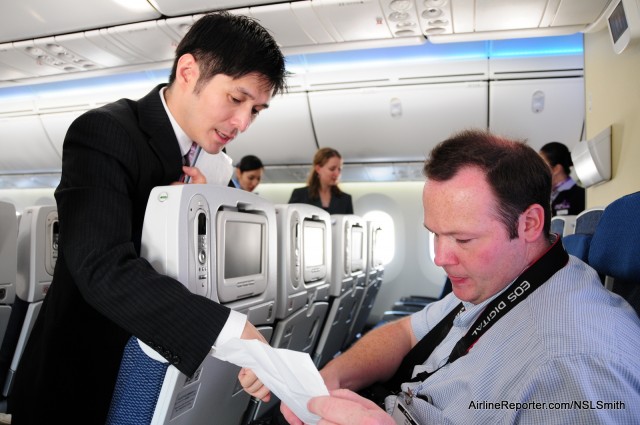
Here I am talking with Ryosei Nomura, who is Senior Manager of Public Relations based in Japan, about my thoughts on the new interior.
One of the interior updates are the fixed back shell economy seats. Those are the type that you can still push your button and the bottom part will move forward, but your actual seatback will not recline. This is to help save space for those behind you. Talking to some ANA folks, they stated they have received some negative feedback, but I really like the concept of the seats. I am one that will rarely reclines my seat out of consideration of those behind me and I hate it when I am working on my laptop and the person in front of me puts back their seat. With the seat in the “reclined” position, my knees were hitting the seat on front of me, but I was assured the longer haul economy will have a larger seat-pitch. But with my seat “un-reclined” I had no problems. Since it is not as obviously if your seat is reclined, each seat has an indicator on the head rest which will quickly show the flight crew if the seat is in proper position for take off or landing.
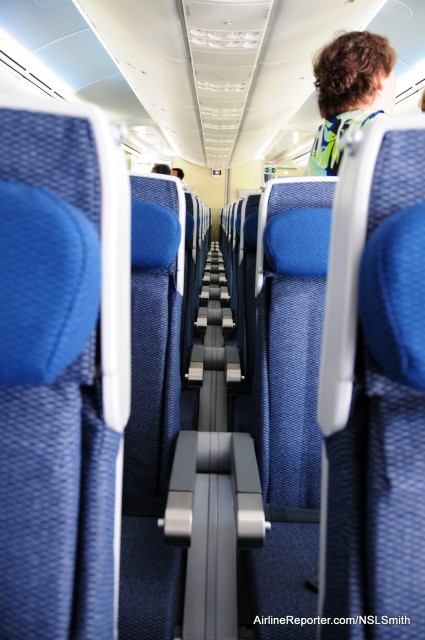
ANA has decided to provide a double armrest in the middle of their 787 Dreamliners.
The first aircraft in domestic configuration is laid out with 12 business class seats in a 2-2-2 layout and 252 economy in a 2-4-2 layout. The short-haul international configuration will contain 42 business class seats and only 180 economy. The long-haul international ANA 787 will fly 46 of the new business class staggered seat and 112 economy, providing more seat-pitch than the domestic aircraft. One aspect of ANA’s economy that wasn’t at first obvious was the center armrests. No one likes to be sitting in the middle of a 2-4-2 layout, but ANA gives passengers a double arm rest in the middle, making the it less painful to have that middle seat.
For the average passenger, it might not be totally obvious they are in a new 787 Dreamliner. However, they should notice that there is something different, something better about the aircraft. For those of us who know airplanes, it is very obvious this is a next-generation airliner. Yes, the 787 has been delayed three years, but once people start flying on them, I doubt many will care. I cannot wait for this to become the new standard in world travel. A big thanks to Boeing and ANA for holding this event and inviting AirlineReporter.com along for the ride.
* See an exterior photo tour of ANA’s first Boeing 787 Dreamliner
* Check out all 39 787 interior tour photos on my Flickr
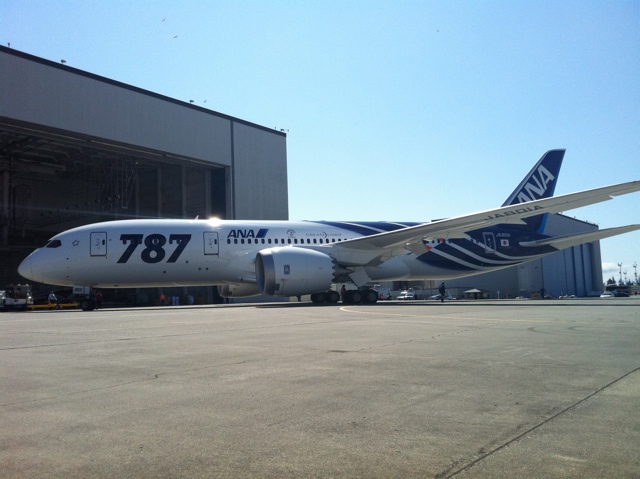
This is ANA's first Boeing 787 Dreamliner (JA801A)
Today, Boeing and All Nippon Airways (ANA) showed off the special livery on the first 787 Dreamliner (ZA101 – JA801A) that is expected to be delivered by the end of September.
As reported previously, the blue lines at the rear of the fuselage are designed to highlight how the three core elements of the airline’s service brand ’“ innovation, uniqueness and the inspiration of modern Japan ’“ operate across the ANA network. Only two Dreamliners will be painted in the special livery, the rest will be in standard ANA livery.
The airline has already announced that they will operate this first Boeing 787 Dreamliner as a charter international flight from Tokyo, Narita to Hong Kong one month after they take delivery.
HIGH QUALITY PHOTOS ARE UP:
* Photos of the 787 Interior
* Photos of the 787 Exterior
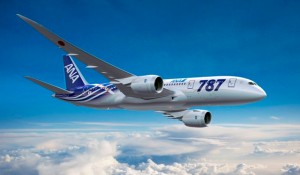
This is what the special livery will look like on the first 787 to be delivered to ANA (ZA101).
Boeing and ANA will be unveiling the special livery on the first Boeing 787 Dreamliner to be delivered, hopefully by the end of September. Boeing has stated the aircraft (ZA101 – Airplane #8) should be rolled out of the paint hangar located at Paine Field at about 3pm PT. You can follow the events live via Twitter (you do not need an account to follow – what is Twitter?):
* My Twitter feed: @AirlineReporter
* Jon Ostrower: @FlightBlogger
* Boeing’s Official: @BoeingAirplanes
* Everyone Tweeting about it: #ANA787
I plan to do a quick post with a photo when it is reveled and then a post later this evening with many more photos, then a later post with a video tour of the interior of the ANA Boeing 787. Stay tuned…
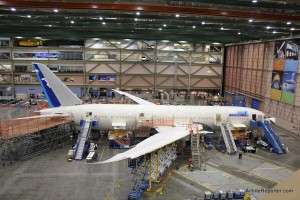
Boeing 787 Dreamliner for ANA in Boeing's factory. Photo by AirlineReporter.com.
Yesterday, I took a look how All Nippon Airways (ANA) and Boeing have worked together to prepare and train for the Boeing 787 Dreamliner. Today, we will explore how ANA directed some of the 787’s development and how their relationship with Boeing and other vendors will continue after they take delivery of the first Dreamliner.
ALL NIPPON AIRWAY’S INPUT
A large benefit of being the launch customer is that the airline gets to have influence over the development of the aircraft. ANA has been able to have a positive impact on the development of the 787 and Boeing has welcomed their input. Finding out how to make the 787 Dreamliner the best plane possible became a team effort. ANA reached out to employees throughout the company to determine what they would like to see in the new plane.
“ANA is much more than a customer for the 787 program. ANA has been a partner in helping us to make important decisions and in understanding our challenges and the solutions that have been developed,’ Scott Fancher, Vice President and General Manager of the 787 Program stated.
On many other aircraft, the front cockpit windows will open, allowing the crew to clean them if needed. The Dreamliner did not have opening windows, so ANA worked with Boeing to develop a window washer system, like you might find on a car that performs that function. ANA has also requested that Boeing develop oxygen masks that would better fit to the shape of Asian face.
EROS which is the manufacturer of the oxygen masks reviewed the data base to fit the various racial faces.
Most of the ideas proposed by ANA have been accepted by Boeing. ’œDuring our discussions, Boeing understood ANA’s requests,’ Mr. Kikuchi explained. ’œAlmost 70% of our unique requests have been implemented on the airplane.’
POST DREAMLINER DELIVERY
According to the most recent buzz, the first 787 Dreamliner is scheduled to be delivered to ANA as early as July 2011. Flight Global reports that the eighth 787 (ZA101) is currently set to be the first aircraft delivered to ANA, configured in a two-class, medium to short-haul set up. According to Boeing, they are not planning to sell the first three test planes, but do plan to sell the rest of the Dreamliners currently being used for testing.
Once Boeing hands over the keys of the first Dreamliner to ANA, the airline and aircraft manufacture will still have a very close relationship in continuing to assist with the development of the 787. For the first three months of ownership, Mr Kikuchi explained that Boeing and other vendors will support ANA strongly.
’œWe are working hard to finish our remaining requirements and look forward to a grand celebration of our first delivery with our good friends from ANA later this year,’ Boeing’s Fancher said. ’œThat delivery will be the first of many and each will be an opportunity to work together and celebrate our mutual accomplishments.”
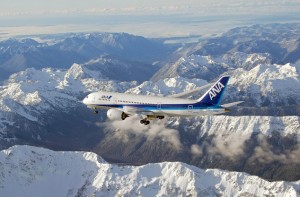
Boeing 787 Dreamliner ZA002 flying high with ANA livery. Photo by Boeing.
CONCLUSION
ANA is very pleased to be the first customer for the 787 and it shows. Much of their marketing has the Dreamliner prominently displayed and even their business cards have ’œ787, We Fly 1st’ printed on them.
All Nippon Airways already has a large presence with over 180 aircraft and over 70 destinations world-wide. They have flown many different types of aircraft since being founded in 1952; from DC-3s to Boeing 727s, they are no stranger to different aircraft types.
The Dreamliner will allow them to be the first to fly the next generation airliner and for many that is a very exciting prospect. It has to be even more exciting for the employees of ANA to know they have had such a direct impact with the 787’s development and that is something to be very proud of.
Talking to ANA About the 787 Dreamliner:
PART 1 | PART 2 | BOTH
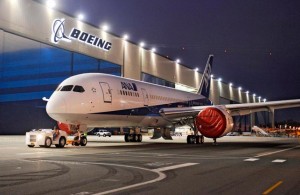
Boeing 787 Dreamliner in ANA livery at Everett Field. Photo by Boeing.
INTRODUCTION
Although the Boeing 787 Dreamliner looks similar to previous aircraft, it uses the next generation of technology and materials. Designing, building and then training for such a complex aircraft is no easy task. How does an airline go about preparing to take delivery of a brand new aircraft?
All Nippon Airways (ANA) will be the first airline to take delivery of the 787 and I recently had the opportunity to sit down with Mr. Takeo Kikuchi, ANA’s General Manager of the USA Engineering Office, and with Nao Gunji, ANA’s Communications Coordinator, to learn more about how they are preparing for the Dreamliner.
Today this story will give some background on the Dreamliner and the training that ANA has completed for the 787. Tomorrow, I will post about ANA’s input on developing the 787 and what happens after they take delivery.
I felt honored to have the opportunity to speak with Mr. Kikuchi. He started working in the airline business in 1980 as a mechanic and did heavy maintenance on classic Boeing 747s in Japan. Subsequently he was responsible for overseeing hydraulic systems on, allowing him to expand his engineering experience. He then worked in public relations for about three years before moving to Seattle in 2007 to lead the local ANA engineering office at Boeing.
Mr. Kikuchi’s main responsibility is to communicate to Boeing the needs of his airline and ensure ANA receives the best quality plane possible. ’œANA’s drive is to purchase a reliable, convenient and usable airplane,’ he explained.
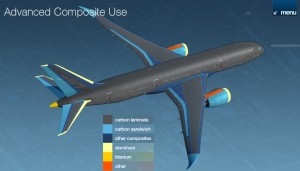
Graphic showing the different materials used in the Boeing 787 Dreamliner. From Boeing.com.
787 AIRCRAFT MATERIALS
The type of materials used is one way the 787 is unique from other aircraft (what makes the 787 different). Currently most aircraft are built using large aluminum panels and are riveted to a metal frame. In contrast, the 787 is constructed using large sections of mostly carbon composite materials that do not need to be riveted. Although the new material makes for a stronger and lighter aircraft, it can provide some challenges.
One of those challenges is how to repair the aircraft. To repair an aluminum aircraft, ANA puts a temporary patch on the affected area and then flies the damaged plane to their maintenance facility in Japan for a permanent repair. With carbon fiber, it is not as easy and will be more difficult to complete a temporary repair before flying to a repair facility. ANA is currently working with Boeing on perfecting the best way to make short-term repairs to the Dreamliner.
One advantage of a carbon fiber repair is the long term benefits. With an aluminum repair, an airplane will have additional squares of aluminum riveted onto the fuselage, causing additional weight and lowering aerodynamics ’“ raising fuel costs. After 787 composite repairs, the change of the aircraft weight and aerodynamics will be minimal, saving money over the lifetime of the airframe.
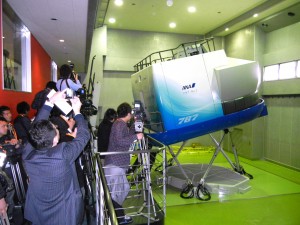
Japanese reporters getting a look at one of the two 787 full flight simulators in action at the Boeing/ANA training campus in Tokyo on March 7. Photo by Boeing.
ANA TRAINING
Although there are many forms of training, nothing beats hands-on experience. Mechanics have started with computerized training, but at some point will be flown from Japan to Paine Field in Everett, WA where the Dreamliner is built. To date, there have been over 100 ANA mechanics, who visit in groups of 10-12, who have been flown to Seattle to train on the Boeing 787 Dreamliner.
Even though there have been ANA pilots who have flown the Dreamliner, not all the pilots will have that chance before the airline takes delivery. The Japanese Civil Aviation Bureau (JCAB) approved Dreamliner simulators at the ANA/Boeing training campus in December 2010. ANA will start 787 pilot training as early as this month.
ANA has invested a lot of time, money and their future into the Boeing 787 Dreamliner and Boeing knows how important their relationship with ANA is. “I can’t say enough about Boeing’s special relationship on 787 crew training with ANA over the past four-plus years, ’ Sherry Carbary Vice President, Flight Services, Boeing Commercial Airplanes said. ’œTheir attention to detail was outstanding and made us better for it.’
After speaking with Mr. Kikuchi, I had a quick tour of the Boeing factory and the 787 production line (sorry, no photos). Now, I am no stranger to the factory, but this was much different tour being that I was guided by an airline representative and hearing their perspective.
While getting a tour of one of their 787 Dreamliners in production, we saw a group of ANA mechanics getting a quick look at the aircraft. Mr. Kikuchi told us that the mechanics would be given a scenario concerning a problem and they would learn how to solve it. It is one thing to talk about the 787 in a conference room versus being out with on the aircraft and seeing the mechanics in action.
Talking to ANA About the 787 Dreamliner:
PART 1 | PART 2 | BOTH














